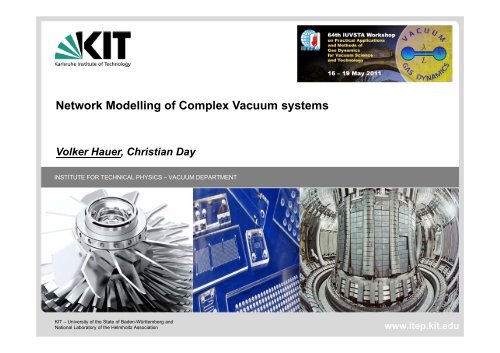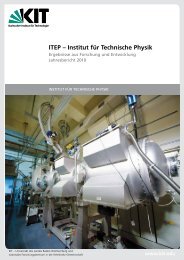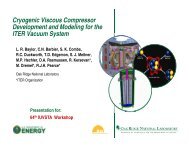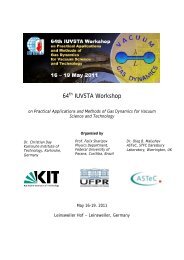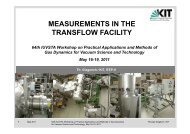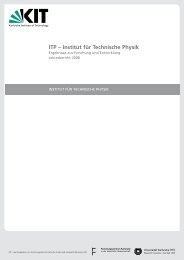Modelling of ITER torus Vacuum system - KIT
Modelling of ITER torus Vacuum system - KIT
Modelling of ITER torus Vacuum system - KIT
You also want an ePaper? Increase the reach of your titles
YUMPU automatically turns print PDFs into web optimized ePapers that Google loves.
Network <strong>Modelling</strong> <strong>of</strong> Complex <strong>Vacuum</strong> <strong>system</strong>s<br />
Volker Hauer, Christian Day<br />
INSTITUTE FOR TECHNICAL PHYSICS – VACUUM DEPARTMENT<br />
<strong>KIT</strong> – University <strong>of</strong> the State <strong>of</strong> Baden-Württemberg and<br />
National Laboratory <strong>of</strong> the Helmholtz Association<br />
www.itep.kit.edu
Outline<br />
1. <strong>ITER</strong>VAC Basics<br />
2. Experimental Validation<br />
3. Simulation <strong>of</strong> the <strong>ITER</strong> Torus <strong>Vacuum</strong> System<br />
4. Conclusions and Outlook<br />
5. References<br />
2 16-19 May, 2011 64th IUVSTA Workshop on <strong>Vacuum</strong> Gas Dynamics, Leinsweiler, Germany<br />
Volker Hauer
Basic framework <strong>of</strong> the <strong>ITER</strong>VAC code<br />
<strong>ITER</strong>VAC baseline equation with 4 fitting parameter for dimensionless mass flow :<br />
�� � �<br />
�� �� � � � � ��<br />
� � ���<br />
Free molecular flow limit:<br />
lim<br />
��→� ��� � �� � �� ���<br />
Viscous flow limit:<br />
lim<br />
��→� �� �� �� ������ ����� �<br />
���� � ��� � 8�<br />
�� � ⁄ � �� 3 16-19 May, 2011 64th IUVSTA Workshop on Practical Applications and Methods <strong>of</strong> Gas Dynamics<br />
for <strong>Vacuum</strong> Science and Technology, May 16-19, 2011<br />
For isothermal, isotropic Maxwellian<br />
distribution<br />
4 �<br />
�� �� �<br />
�� � � More general<br />
approach:<br />
��� 16 �<br />
� � ���� �<br />
Volker Hauer
Interpretation <strong>of</strong> the factors c i<br />
c 1<br />
c 2 + c 3<br />
c 4<br />
→ viscous flow limit (known from CFD)<br />
→ free molecular flow limit (known from TPMC)<br />
→ fixed parameter describing the influence <strong>of</strong> the beaming effect<br />
The factors c i are known and can be used for predictive simulations.<br />
Geometry clam c2 c3 c4 Circular 1.0 1.1162 0.3291 1.4<br />
Square 1.12462 1.4862 0.5735 1.4<br />
Rectangular (2x1) 1.02907 1.6655 0.7318 1.4<br />
Triangular 1.2 1.9706 0.9632 1.4<br />
Elliptic (2x1) 0.95108 1.3404 0.5054 1.4<br />
Infinite gap 2/3 0.7133 1.1918 1.4<br />
For short channels (L/d
Kn<br />
1<br />
0.1<br />
0.01<br />
Flow regimes - Approaches<br />
�<br />
0<br />
Boltzmann<br />
equation or<br />
Kinetic<br />
equations<br />
(BGK, S)<br />
DSMC / Test particle MC / MD /<br />
Method <strong>of</strong> Angular Coefficients. etc<br />
DSMC / Empirical etc.<br />
Navier-Stokes with slip boundary conditions<br />
<strong>ITER</strong>VAC,<br />
LOPSTER Navier-Stokes with no slip boundary<br />
conditions/ Euler equations<br />
This talk<br />
ProVac3D – A Test Particle Monte<br />
Carlo Program For Complex<br />
<strong>Vacuum</strong> Systems. Xueli Luo<br />
5 16-19 May, 2011 64th IUVSTA Workshop on Practical Applications and Methods <strong>of</strong> Gas Dynamics<br />
for <strong>Vacuum</strong> Science and Technology, May 16-19, 2011<br />
Benchmark Problem.<br />
Direct Simulation Monte<br />
Carlo <strong>of</strong> Gas Flow<br />
Through an Orifice and<br />
Short Tube.<br />
Stylianos Varoutis<br />
Volker Hauer
Capabilities <strong>of</strong> <strong>ITER</strong>VAC<br />
Provide the modeling capability for networks <strong>of</strong> channels<br />
describe the flows in the whole range <strong>of</strong> the Knudsen number with an<br />
acceptable (not best possible) accuracy<br />
produce the calculation results in a short time<br />
best for use within the process <strong>of</strong> vacuum <strong>system</strong> design<br />
6 16-19 May, 2011 64th IUVSTA Workshop on <strong>Vacuum</strong> Gas Dynamics, Leinsweiler, Germany<br />
Volker Hauer
<strong>ITER</strong>VAC networking<br />
<strong>ITER</strong>VAC provides the user with all tools to build up 2D networks.<br />
gas source<br />
binding node<br />
channel<br />
<strong>ITER</strong>VAC calculates the mass flow rate through every channel depending on the<br />
pressure <strong>of</strong> the gas source and inside the pumps.<br />
7 16-19 May, 2011 64th IUVSTA Workshop on Practical Applications and Methods <strong>of</strong> Gas Dynamics<br />
for <strong>Vacuum</strong> Science and Technology, May 16-19, 2011<br />
pump<br />
Volker Hauer
Experimental validation <strong>of</strong> <strong>ITER</strong>VAC<br />
� Simulations with <strong>ITER</strong>VAC were performed and compared with the experimental<br />
results <strong>of</strong> measurements with circular channels with a length to diameter ratio <strong>of</strong><br />
80, 60, 40, 10.<br />
� The diameter <strong>of</strong> all test channel is 16 mm. The lengths are 1280, 963, 644 and 157<br />
mm, respectively.<br />
� Knudsen numbers and conductances are calculated for 273 K.<br />
� The experiments were performed in the TRANSFLOW test rig (see presentation <strong>of</strong><br />
T. Giegerich at Monday).<br />
8 16-19 May, 2011 64th IUVSTA Workshop on Practical Applications and Methods <strong>of</strong> Gas Dynamics<br />
for <strong>Vacuum</strong> Science and Technology, May 16-19, 2011<br />
Volker Hauer
Conductance [l/s]<br />
Results L/d=80 and 60<br />
12<br />
10<br />
8<br />
6<br />
4<br />
2<br />
0<br />
0,00 0,01 0,10<br />
Knudsen number<br />
1,00 10,00<br />
9 16-19 May, 2011 64th IUVSTA Workshop on Practical Applications and Methods <strong>of</strong> Gas Dynamics<br />
for <strong>Vacuum</strong> Science and Technology, May 16-19, 2011<br />
L/d=80; Experiment<br />
l/d=80; Simulation<br />
L/d=60; Experiment<br />
L/d=60; Simulation<br />
Volker Hauer
Conductance [l/s]<br />
Results L/d=40 and 10<br />
14<br />
12<br />
10<br />
8<br />
6<br />
4<br />
2<br />
0<br />
0,00 0,01 0,10 1,00 10,00 100,00<br />
Knudsen number<br />
10 16-19 May, 2011 64th IUVSTA Workshop on Practical Applications and Methods <strong>of</strong> Gas Dynamics<br />
for <strong>Vacuum</strong> Science and Technology, May 16-19, 2011<br />
L/d=40; Experiment<br />
l/d=40; Simulation<br />
L/d=10; Experiment<br />
L/d=10; Simulation<br />
Volker Hauer
<strong>Modelling</strong> <strong>of</strong> <strong>ITER</strong> <strong>torus</strong> <strong>Vacuum</strong> <strong>system</strong> (1)<br />
Complex vacuum <strong>system</strong>s in <strong>ITER</strong><br />
11 16-19 May, 2011 64th IUVSTA Workshop on Practical Applications and Methods <strong>of</strong> Gas Dynamics<br />
for <strong>Vacuum</strong> Science and Technology, May 16-19, 2011<br />
Torus vacuum <strong>system</strong><br />
Throughputs and pressure differences are needed in all flow regimes.<br />
Volker Hauer
<strong>Modelling</strong> <strong>of</strong> <strong>ITER</strong> <strong>torus</strong> <strong>Vacuum</strong> <strong>system</strong> (2)<br />
12 16-19 May, 2011 64th IUVSTA Workshop on Practical Applications and Methods <strong>of</strong> Gas Dynamics<br />
for <strong>Vacuum</strong> Science and Technology, May 16-19, 2011<br />
The <strong>ITER</strong>VAC model includes:<br />
� The flow path <strong>of</strong> the 54<br />
divertor cassettes,<br />
� 4 pumping ducts and the<br />
connection to the 8<br />
cryopumps,<br />
� The flow path caused by bypass<br />
leaks,<br />
� The blockage by diagnostic<br />
tools.<br />
Volker Hauer
<strong>Modelling</strong> <strong>of</strong> <strong>ITER</strong> <strong>torus</strong> <strong>Vacuum</strong> <strong>system</strong> (3)<br />
Maximum Throughput [Pa m³/s]<br />
Resulted maximum throughput for deuterium:<br />
4500<br />
4000<br />
3500<br />
3000<br />
2500<br />
2000<br />
1500<br />
1000<br />
500<br />
0<br />
Torus pumps<br />
Plasma<br />
0 2 4 6 8 10 12<br />
Divertor dome pressure [Pa]<br />
13 16-19 May, 2011 64th IUVSTA Workshop on Practical Applications and Methods <strong>of</strong> Gas Dynamics<br />
for <strong>Vacuum</strong> Science and Technology, May 16-19, 2011<br />
Input parameter:<br />
� divertor pressure 1-10 Pa<br />
� deuterium (single gas)<br />
� temperature 420 K<br />
Volker Hauer
Conclusions and Outlook<br />
� In all cases, a good agreement is observed between corresponding numerical and<br />
experimental results for specific range <strong>of</strong> Knudsen number. The best agreement<br />
was found for the channel with L/d=10.<br />
� The average relative error is <strong>of</strong> the order <strong>of</strong> 20%.<br />
� The largest discrepancies between experimental and numerical results are<br />
observed in laminar flows, whereas in the free molecular regime the smallest<br />
differences are found.<br />
� The present work will be extended to the study <strong>of</strong> different cross sections and in the<br />
intermediate length range <strong>of</strong> 5< L/D h
References (1)<br />
Proceedings:<br />
1. C. Day, V. Hauer, G. Class, D. Valougeorgis, and M. Wykes, “Development <strong>of</strong> a<br />
simulation code for <strong>ITER</strong> vacuum flows”, IAEA Fusion Energy Conference,<br />
Chengdu, China (2006).<br />
2. S. Varoutis, V. Hauer, C. Day, “Investigation <strong>of</strong> gas flows in fusion reactors”. AVS<br />
56th International Symposium, San Jose-California, USA (2009).<br />
3. S. Varoutis, V. Hauer, C. Day, S. Pantazis and D. Valougeorgis, “Experimental and<br />
numerical investigation in flow configurations related to the vacuum <strong>system</strong>s <strong>of</strong><br />
fusion reactors”. 9th International Symposium on Fusion Nuclear Technology,<br />
Dalian, China (2009).<br />
15 16-19 May, 2011 64th IUVSTA Workshop on Practical Applications and Methods <strong>of</strong> Gas Dynamics<br />
for <strong>Vacuum</strong> Science and Technology, May 16-19, 2011<br />
Volker Hauer
References (2)<br />
Journals:<br />
4. S. Varoutis, S. Naris, V. Hauer, C. Day and D. Valougeorgis, “Experimental and<br />
computational investigation <strong>of</strong> gas flows through long channels <strong>of</strong> various cross<br />
sections in the whole range <strong>of</strong> the Knudsen number”, JVSTA, 27 (1), 89-100<br />
(2009).<br />
5. S. Varoutis, V. Hauer, C. Day, S. Pantazis and D. Valougeorgis, “Experimental<br />
and numerical investigation in flow configurations related to the vacuum<br />
<strong>system</strong>s <strong>of</strong> fusion reactors”, FED, 85, 1798–1802 (2010).<br />
6. V. Hauer, Chr. Day, “Conductance modelling <strong>of</strong> <strong>ITER</strong> vacuum <strong>system</strong>s”, FED, 84,<br />
903–907 (2009).<br />
16 16-19 May, 2011 64th IUVSTA Workshop on Practical Applications and Methods <strong>of</strong> Gas Dynamics<br />
for <strong>Vacuum</strong> Science and Technology, May 16-19, 2011<br />
Volker Hauer


